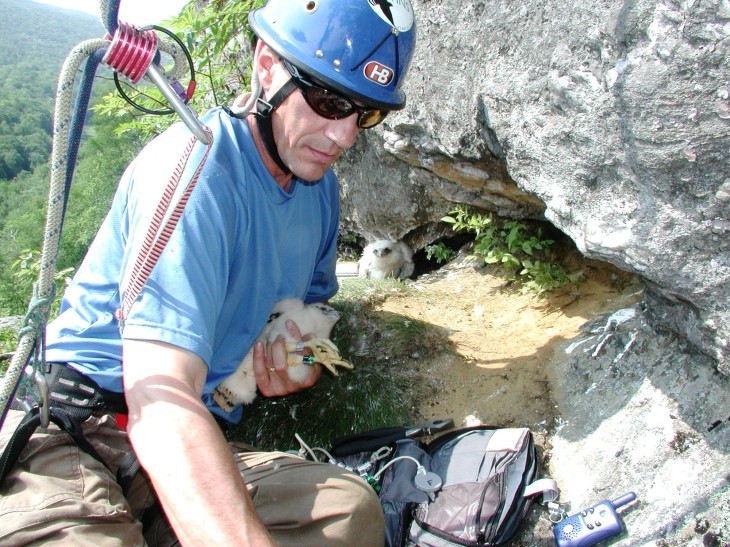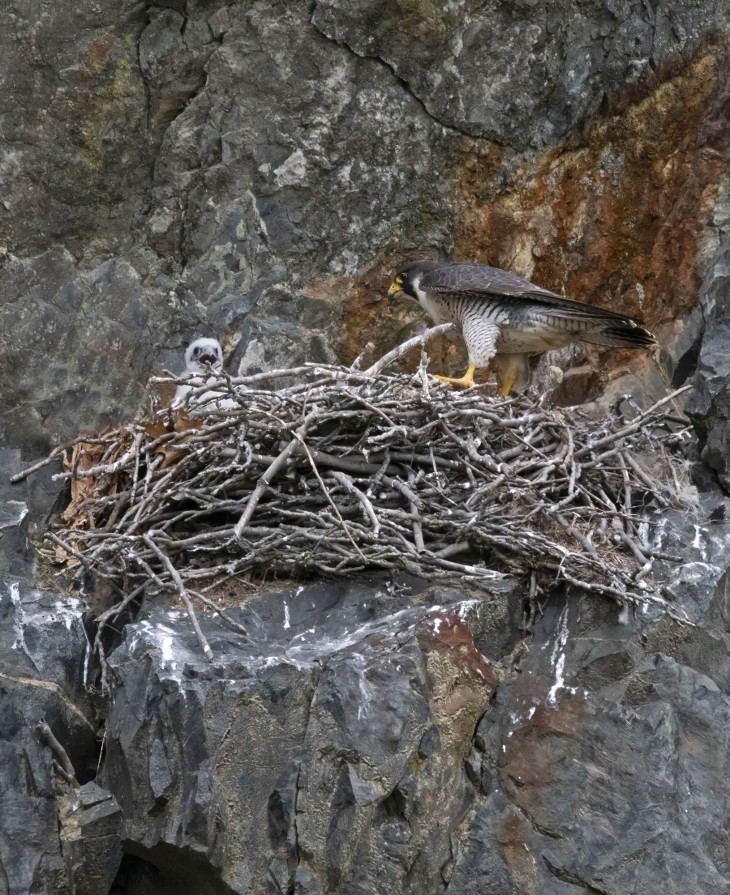
In early spring, as rock climbers flock to sunny cliffs and crags throughout the Northeast, peregrine falcons are also returning, seeking mates and establishing nesting sites.
Populations of peregrines and other raptors plummeted in the Northeast during the mid-1900s. The main factor in this decline was widespread use of the insecticide DDT, which peregrines and other birds at the top of the food chain ingested through eating contaminated prey. The chemical weakened the shells of the birds’ eggs, causing them to break before chicks could hatch. Peregrine falcons were listed as federally endangered in 1970.
The federal government banned DDT in 1972, and the U.S. Fish & Wildlife Service, the Peregrine Fund, and other organizations began an effort to help the species recover. That recovery has been slow and steady. Peregrines were removed from the federally endangered list in 1999, although states including Maine, New Jersey, Rhode Island, and New York continue to list the birds as endangered. New Hampshire and Connecticut have updated peregrines’ status to threatened, and Vermont and Pennsylvania consider the peregrine falcon a recovered species.
One way wildlife conservationists continue to protect the species is by closing cliffs and trails to rock climbers and other recreationalists during the critical nesting season, typically from April 1 through August 1. Temporarily shutting down human access to nesting areas allows these raptors the space they need to fledge their young. It also highlights a long collaborative relationship between recreational rock climbers and conservation scientists.

“When Falcon reintroduction began, it was quickly evident that climbers and falcons experience challenges sharing the same territory,” said Travis Peckham, a Vermont climber and guidebook author. “Climbers learned that falcon nests can fail if disturbed, and that falcons can be aggressively territorial. More than a few of us have retreated off a cliff when a falcon has made it clear that we’re not wanted.”
During mating and nesting seasons, falcons protect their aeries from perceived threats, including ravens, raccoons, and rock climbers. If the birds have to spend too much time and energy fending off threats, they are unable to adequately incubate their eggs and care for chicks.
A cliff closure typically includes a wide area around the nest, providing enough space for peregrine parents to feel secure. Besides protecting breeding birds, early cliff closures also allow wildlife biologists and volunteer community scientists the chance to monitor the falcon population and to determine how pairs fared through winter.
Peregrines often nest in areas difficult to access – unless you have the skills and equipment to scale rock faces – and in the early days of the peregrine falcon recovery efforts, climbers were essential partners to wildlife biologists. Some biologists recruited climbers to help safely access nests and to band chicks, which allowed researchers to better track their movement and fledgling rate and to assess overall population health. Peckham was one of these climbers, working with biologists from Audubon Vermont and Vermont Institute of Natural Science to reach peregrine nests during the 1990s and early 2000s.
“My role was to guide the biologists to the nests, which were typically located in technical climbing terrain. We would put leg bands on each chick and check them for ear mites and other general health issues,” he said, adding that in more recent years, Vermont biologists have ended their banding efforts. “As the falcons moved from endangered to threatened status, and it was clear that they were recovering well, banding was retired.”
While he no longer guides biologists to peregrine aeries, Peckham continues to be a voice for climbing stewardship. He said the early collaboration between climbers and scientists laid the groundwork for a cooperative system of temporary recreational cliff closures in Vermont and elsewhere.
In Vermont, state biologists rely heavily on volunteer observations to determine the timing and specific locations for cliff closures. Cliff closures are implemented through close collaboration among Vermont Fish & Wildlife, Audubon Vermont, Vermont Institute of Natural Science, Green Mountain National Forest, and private landowners. If a nesting area is not on state or conservation land, biologists will alert the landowner and advocate for monitoring during the nesting season in addition to a recreational cliff closure if human activities could threaten the nesting pair.
“If the cliff is small, it is usually entirely closed to climbing,” said Peckham. “If it’s a large cliff, like Marshfield Ledge, climbers have negotiated with Audubon to close only the sections of the cliff that the falcons need to feel safe and secure in their nesting.”
As the peregrine population has stabilized – Audubon Vermont estimates 60 pairs of breeding birds throughout the state – community scientists have taken over nesting season cliff visits from biologists. These volunteers, often retired professionals with an interest in birding, record peregrine activity during 3-hour observations at each cliff, at least once per month, and submit the information through an online recording system, which helps inform biologists on how to manage the birds. If biologists deem a closure necessary, they will reach out to recreational organizations to help spread the word.
Implementing closures can be a challenge. Before the internet, according to Margaret Fowle, conservation program manager at Audubon Vermont, the organization mailed brochures to outdoor gear stores, Vermont Fish & Wildlife, and Green Mountain National Forest. As climbing has gained popularity, various climbing organizations have started to collaborate with state and conservation agencies to help protect access to climbing routes and to encourage stewardship of these areas and the wildlife that live there. These groups are often helpful in posting and sharing information about route closures.
In Vermont, the Climbing Resource Access Group of Vermont (CRAG-VT), a climbing advocacy group active throughout the state, collaborates with Audubon Vermont biologists each spring to determine where peregrines are nesting and which routes and trails should be closed. CRAG-VT also posts those closures on its website.
“Active closures affect about a half-dozen or so [Vermont] climbing areas annually,” said Peckham. “Working within those restrictions has become part of our annual routine.”


